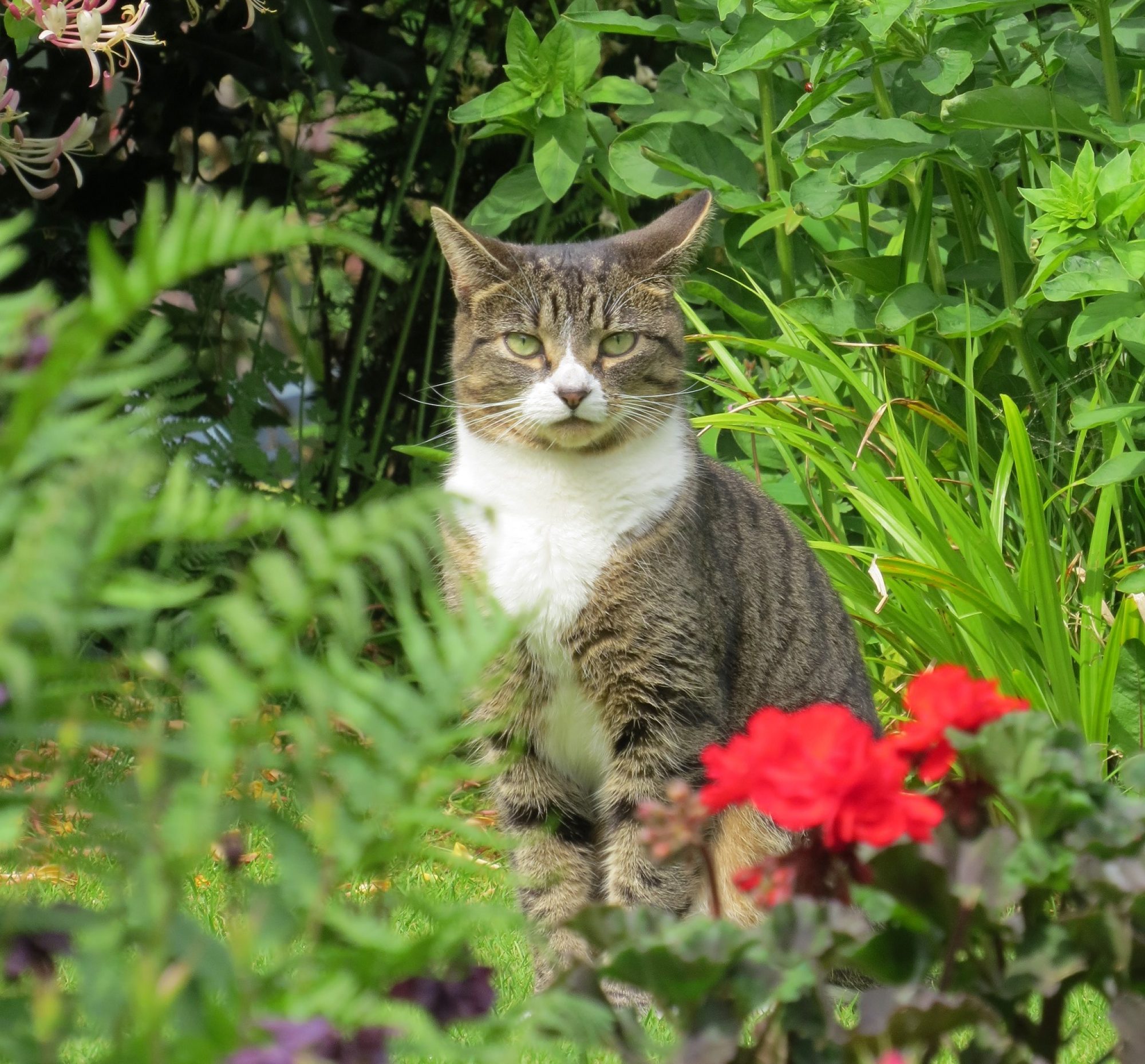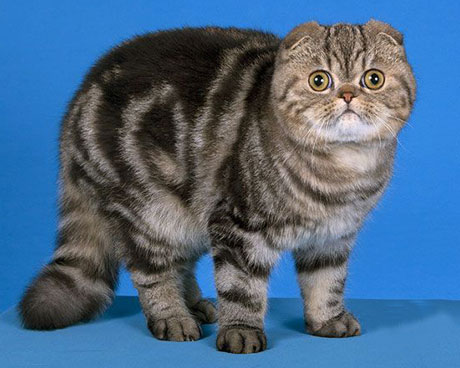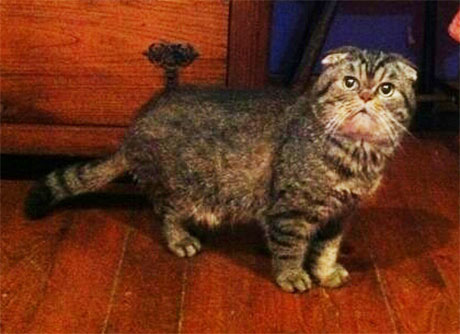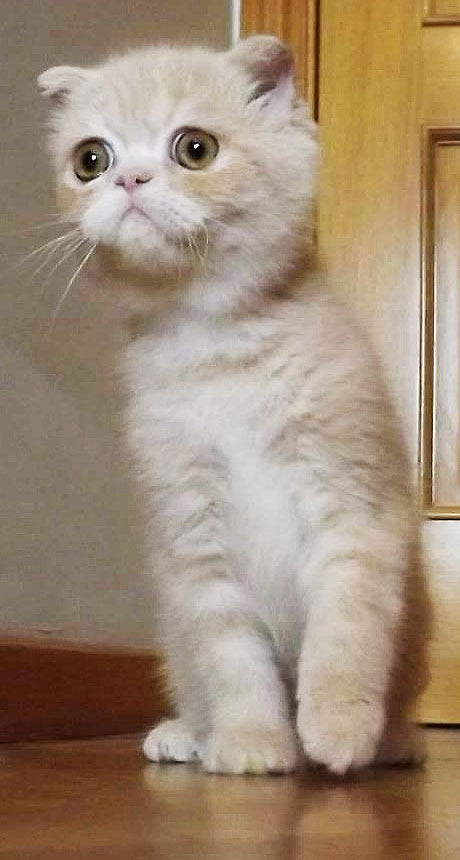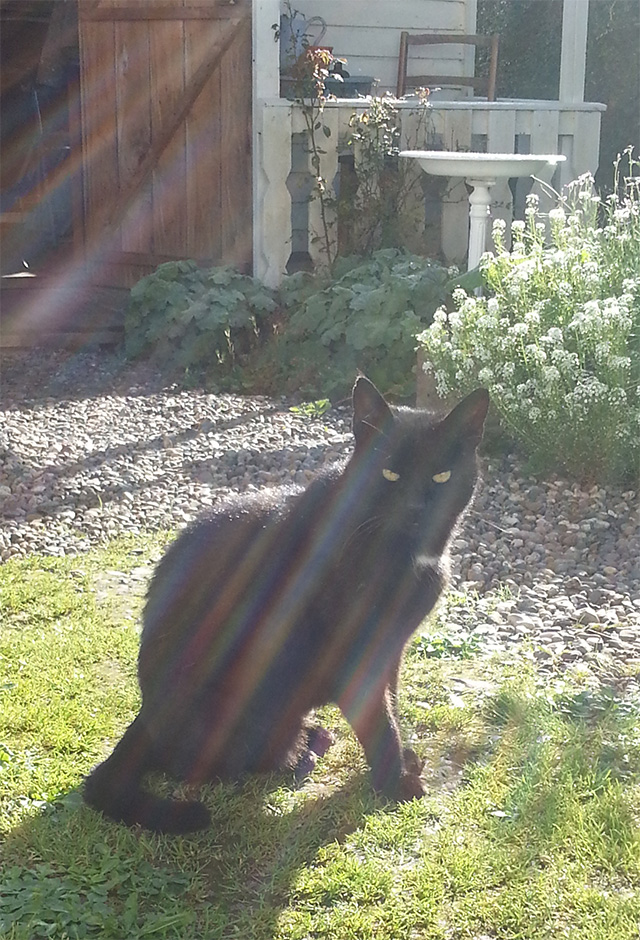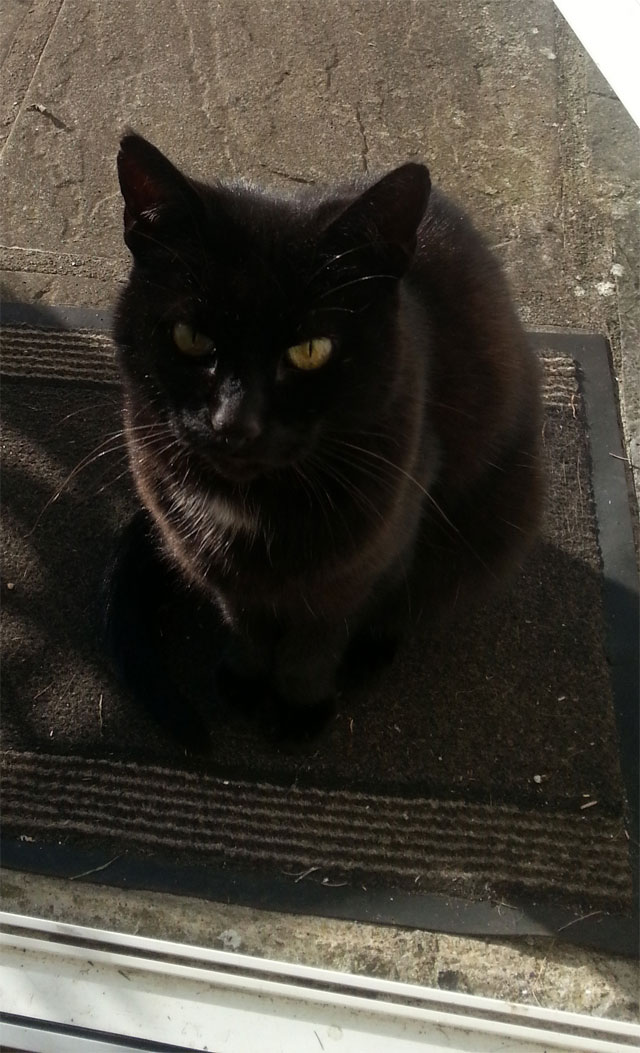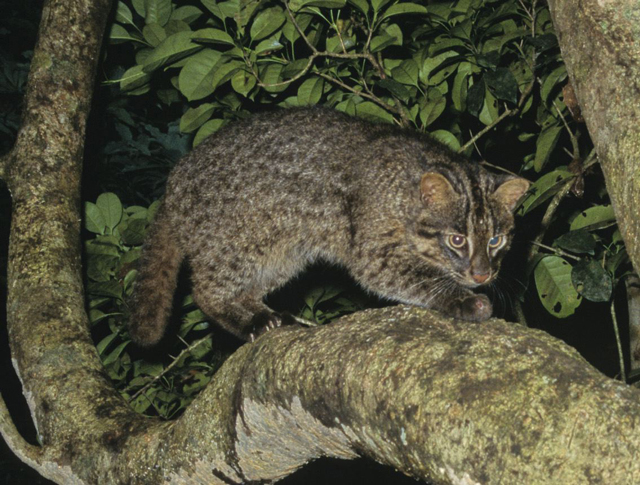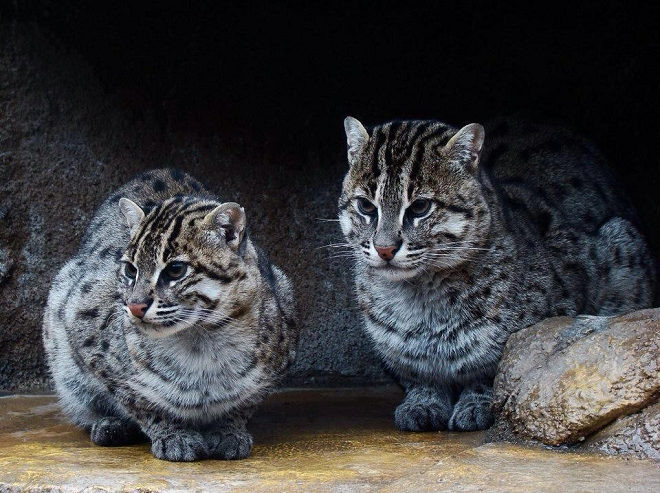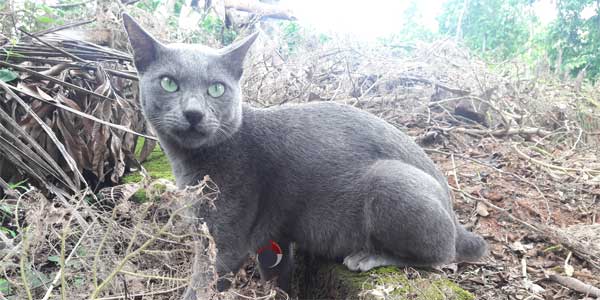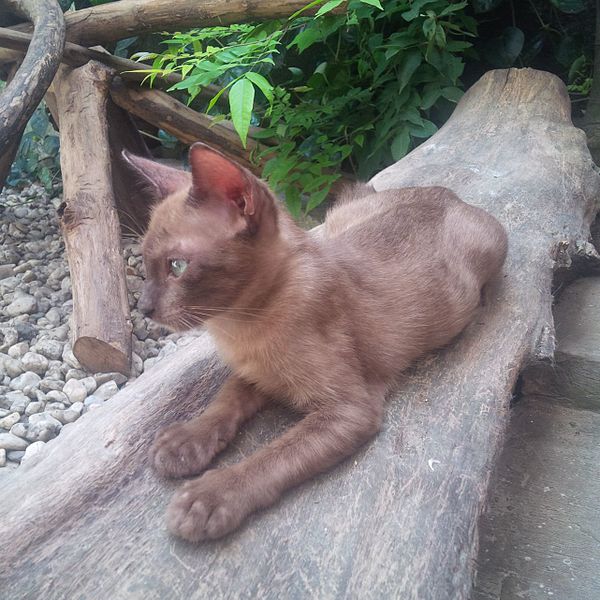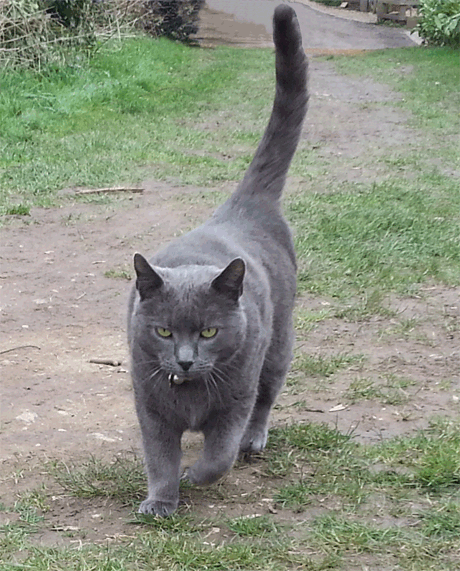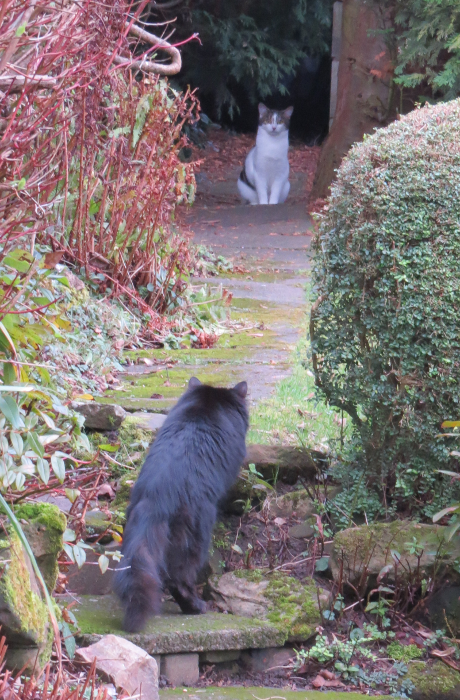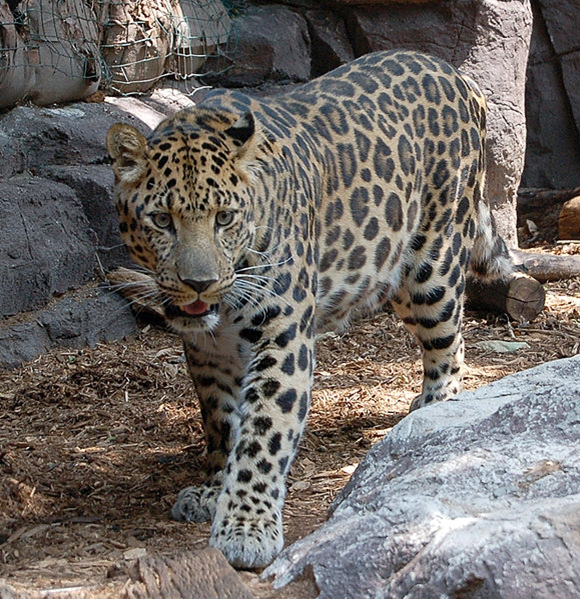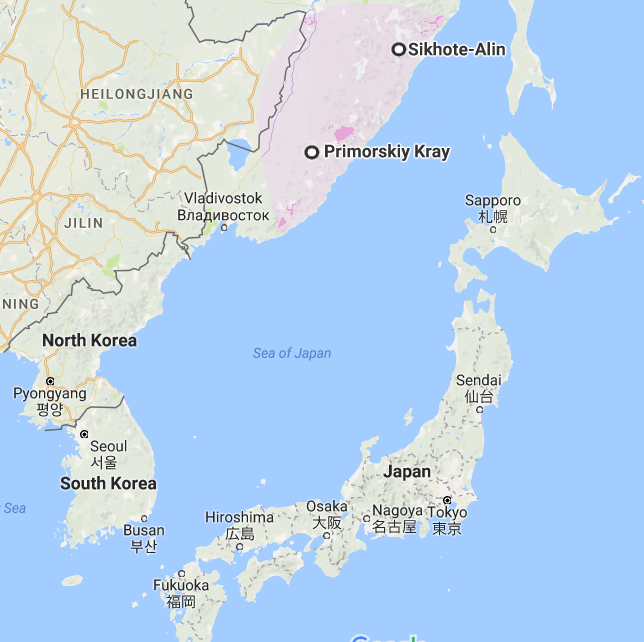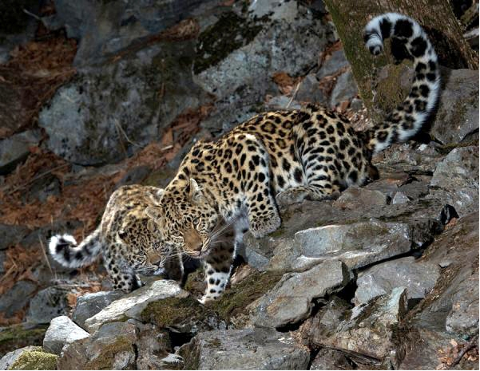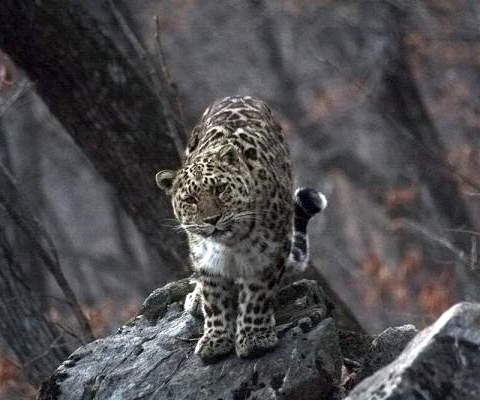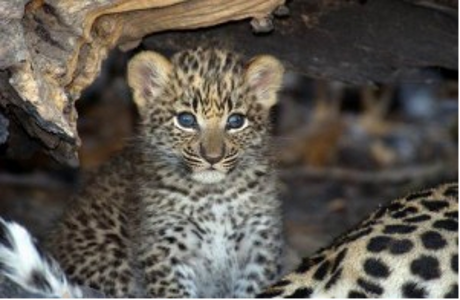The Foldex cat breed was established by cross breeding both Exotic Shorthair and Exotic Longhair breeds with the Scottish Fold breed – it’s distinguishing feature (which characterises the Foldex breed) is a highly rounded, gathered and folded pair of ears.
Cat of the Month ~ December 2017
The Foldex breed first appeared around 1992 in Quebec, Canada as an experimental breed. This cross breeding resulted is a new Persian type breed with folded ears. This animal made its first appearance in a show hall in 1993, being presented by Betty Ann Yaxley. On viewing and admiring this new feline Jeanne Barrette dedicated herself to work with this animal well into the future. Consequently the Foldex breed was accepted as an ‘Experimental Breed’ in November of 1998 and in August of 2006 it was accepted as a New Breed for championship (cat show) status. However it is only recognised by the Canadian Cat Association (CCA).
The Foldex breed has a shorter nose than the Scottish Fold breed. Their body type is sturdy and muscular with good bone structure, a stubby neck, round eyes and a round head that give the breed a very owl like appearance. The folded ears further make the cat a little like a small ‘teddy bear’. Fully grown the weight of this cat is around five to eight pounds. Coats are dense and soft to the touch and can be long or short. The Foldex breed comes in a large variety of colours and patterns.
If allowed to breed these folded ear cats must be crossed with a straight ear cat. This must be done to avoid the potential skeletal defects associated with the breed.
Suprisingly, all Foldex breed kittens are born with straight ears. At three to four weeks the ears begin to start to bend and then fold on many of these kittens.
Many vets recommend that ears will require special cleaning care to prevent infections such as might living in the ear canal.
These felines are highly intelligent, inquisitive (of course), loving and noble cats. The make good house cats as they have a calm and docile temperament (close to that of the Exotic). While they are mostly quiet they often do like to get envolved with what’s going on in the house. The also like to play and interact with us humans when thye are in the mood.
Blackie
Cat of the Month ~ September 2017
Blackie is a faithful 3 year old domestic cat with great hunting ability. She lives in County Roscommon in the republic of Ireland where life is peaceful and slow for most. But if you are a bird or a mouse you’d better have your wits about you when Blackie is about!
She is often seen depositing little presents on her cottage doorstep, accompanied by great howls of “look at me” and “a’rnt I a clever puss”.
Hey Osc, you could learn a thing or two from this here puss
The Iriomote Cat
Cat of the Month ~ July 2017
The Iriomote cat is probably a subspecies of the leopard cat or may be the sole member of an entirely separate genus (Mayailurus Iriomotensis)….who knows!
Iriomote live only on the small Japanese island of Iriomote or ‘Iriomote-jima’ and nowhere else on the planet. The island lies 200 kilometers to the east of Taiwan and has a total area of 113 square miles (292 sq km).
Iriomote cats have a dark grey and brown fur colour with lighter hair on the belly and insides of the limbs. The sides are marked with rows of dark brown spots, which often form into stripes around the neck and legs. It has been observed that the Iriomote cat has a relatively elongate and low-slung build, with short legs. The tail is dark brown (with a darker spots pattern on the back sides) whilst the underside of the tail is solid dark brown as is the very tip of the tail. It has rounded ears with black fur spread along the edges. Adult Iriomote cats have a white spot on the back of each ear, much like those found on tigers’ ears. Young Iriomote cats do not have these marks, and even as adults the spots will not be as white as those seen on other leopard cat subspecies. Its eyes are a light amber shade and there are two dark brown spots on each cheek.
Habitat
Iriomote cats have been seen in wooded mountainous areas, open country and even mangrove swamps and beaches along the island shores. They will though also climb trees, wade into water and even swim. It is thought to spend most of its time alone and, like many wild cats, is mostly nocturnal and especially active during twilight hours. During the daytime, they tend to sleep in tree hollows or in caves (out of the heat of the day and no doubt away from human disturbance). To mark territory they will urinate and defecate on rocks, tree stumps and bushes. Their home ranges vary from 1 to 7 sq km (or 0.38 to 2.7 sq miles) in area.
Food
Recent studies into the cat’s diet reveal that its prey includes animals such as fruit bats, birds, wild pig, rodents, reptiles, amphibians, and crab. The cat also can swim well and will catch fish if the opportunity presents. It has been shown that these cats prefer areas near rivers, forest edges, and places with low humidity.
Iriomote cats are carnivorous and prey on various mammals, birds, reptiles, amphibians, fish, and crustaceans. They typically ingest 400–600 gramms (0.88–1.32 lb) of food a day. Other wild cats primarily hunt small mammals, such as rodents and rabbits, but because there are no other carnivores to compete with the Iriomote cat on the island, there is no need for them to isolate themselves from the various habitats and food sources that are available. Thus, their diet is quite varied.
Mammalian prey includes black rats, Ryukyu flying foxes and young Ryukyu wild boar. Their prey also includes a wide range of birds, such as the spot-billed duck, slaty-legged crake, Eurasian scops-owl, pale thrush, and white-breasted waterhen. Reptiles include various types of snakes and Kishinoue’s giant skink. They are also known to hunt Sakishima rice frogs, yellow-spotted crickets and crabs. As their hunting grounds tend to be in swamps or on shores, they sometimes swim and dive to catch water birds, fish, and freshwater prawns.
When eating birds that are larger than a dusky thrush, most types of cats will pluck the feathers and then eat it, but the Iriomote cat will eat even large birds whole without removing the feathers. “How big is a dusky thrush Ed?”….no idea Osc… let me just look that up.
Since the Iriomote cat mainly inhabits the lowland coastal regions of the island, the cat is in direct conflict with the island’s human population. Recent estimates have put the total Iriomote cat population to be as low as 100 individuals. The threats to this rare cat are loss of habitat, growing competition from the island’s feral cat population, and tourism.
Names
The Iriomote cat (Prionailurus bengalensis iriomotensis) was discovered in 1965 by Yukio Togawa (戸川幸夫 Togawa Yukio), an author who specialized in works about animals. In 1967, it was first described by Yoshinori Imaizumi, director of the zoological department of the National Museum of Nature and Science in Tokyo. However before its scientific discovery, the Iriomote cat was known locally by various beautiful names. In Japanese, the cat is called Iriomote-yamaneko (西表山猫, “Iriomote mountain cat”). In local dialects of the Yaeyama language, it is known as yamamayaa (ヤママヤー, “the cat in the mountain”), yamapikaryaa (ヤマピカリャー, “that which shines on the mountain”), and meepisukaryaa (メーピスカリャー, “that which has flashing eyes”).
This small cat has been listed as critically endangered on the IUCN Red List since 2008, as the only population comprises fewer than 250 adult individuals and is considered declining. As of 2007, there were an estimated 100–109 individuals remaining. It is certainly one of the rarest of cats, with its entire population contained on one Japanese island.
Source: From Wikipedia & others
Myths of the Raas Cat
Cat of the Month ~ May 2017
The Raas cat is a native animal on the Indonesian island of Raas in East Java. The Rass Cat is also known as a Busok or Buso Madura (or just Madura) cat. It is said that the Raas cat is from a pure breed line without mixed genes from other cat races. However this cat is not yet recognised by
Tica as a cat breed.
Raas village cats are considered very special and are highly protected by local inhabitants who, it is said, prevent export of these cats from the island shores. They are known to the islanders as either “Cat Buso” (grey cat), or “Cat Madura” (blue cat). It is believed the blue-gray or Maew Boran stock had been taken to the island on trading ships many years ago.
The Madura breed is now in decline and this has been documented in a study carried out by Lesley Morgan (ACF – Australia) and Dr. Ronny Rachman Noor (Faculty of Animal Science, Bogor Agricultural University). The study also concluded that these cats may be descended from the Korat cat breed and that they are now a closed colony of bobtailed blue cats. It appears that the declining numbers of cats of this type on both Raas and on Madura suggest a high degree of in-breeding and weakening of the breed. A further trait of these cats is that some have cinnamon coat color. These are rarer to find and known as Amethyst Raas.
The study continues: ‘…the cats posture and the triangular facial shape are similar to the ‘leopard’. The cats are large with a medium length tail with a visible bend or kink at the end. The true Madura cat (buso) is solid gray often with lavender nose leather. A few so-called Madura cats found on Madura Island have brown sepia, mink and colourpoint patterns as well as blue bi-colours. This is due to mating with local cats in the region’. The study goes on to mention the variety of cross-bred cats found on the surrounding islands, including; Korat, Burmese, Tonkinese (mink) and Siamese. Each of these had kinked tails typical of the Raas cat which further shows that cross breeding has occurred.
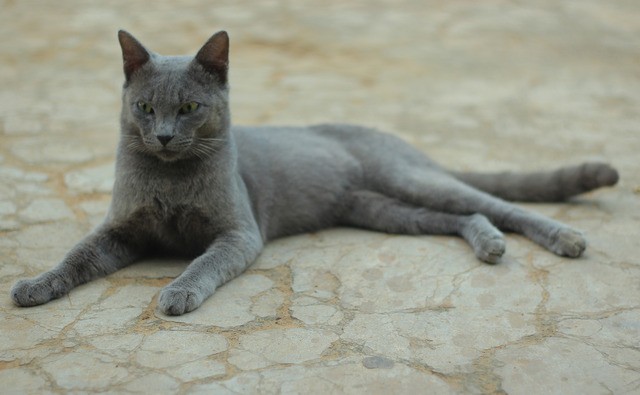
There are several myths surrounding the Raas breed. It is said that:
- the Raas cat is believed to have a sixth sense
- the true Madurese paint (i.e. cat) originating from Raas Island, may only be kept by ‘important’ people such as religious leaders and high ranking government officials.
- anyone attempting to smuggle a cat from Raas island (especially if they are an unmarried person,) will find … “their boat sinking!”
- if the said person survives the shipwreck then that person will instead be dogged with misfortune.
For more information on the Raas cat visit the official Site of the Raas Cat. Please note that a web page translation may be required.
St Patrick’s Day Cat
Cat of the Month ~ March 2017
A sturdy, friendly animal
Photograph: © Ed
Well Wouldn’t you know it!
On this here St Patrick’s day we happened upon this beautiful creature on the Grand Union canal towpath in Warwickshire. He looked a bit ‘Russian Blue’ to our untrained eyes. He was a sturdy puss with lots of muscle around his shoulders. Working out in his home made gym in the garage we mused … and such a friendly animal too …no claws in sight.
On inspecting the collar around his neck we found an attached enameled shamrock….. now surely that must be a good luck omen!
We duly made the said moggy cat of the Month
So, Happy Saint Patrick’s day one and all!
From Ed and Oscar
My Feline Valentine
There’s a new cat on the block and she turned my head the moment I set my eyes on her.
We have been face to face with only a bit of growling (certainly no howling), so who knows where this could lead….
Its safe to say that she is my valentine (for this year at least)….and I don’t even know her name.
Love n’ Purrs,
Little Oscar.
The Rarest Leopard
Cat of the Month ~ January 2017
The Far Eastern leopard (Pantera pardus orientalis) is the rarest surviving subspecies of leopard. The only surviving Far Eastern leopard population is in the southern Far East of Russia. Today it numbers between just 30 and 50 animals.
It was only in 1972 that collected information on the rare Far Eastern wild cat was summarised in an official document by Vladimir Geptner and Arkady Sludsky. It noted that only three isolated groupings of Far Eastern leopards exist in the Far East: at Prikhankaisky, in southern Sikhote-Alin, and one in the Nadyozhdinsky and Khasansky Districts in the southwest of the Primorye Territory.
The Far Eastern leopard used to live at the Komarov Ussuri State Nature Reserve and was an unprotected species both in the reserve and in the surrounding areas. During the 1930s and 1940s all predators, including the leopard, were routinely destroyed, both at the Ussuri and other nature reserves. From 1956, hunting leopards was officially outlawed, but the economic development of the leopard’s natural habitat, especially deer parks, had a negative impact on the stability of the population. These factors, together with a sharp increase in poaching, led to a significant decline in the population and a sharp decrease in the geographical range inhabited by the leopard. It’s notable that the Eastern Leopard also shares its habitat with the Siberian Tiger, which likely competes for available prey stocks.
Detailed studies of the current distribution, numbers, and structures of the populations, the social organisation, reproduction, food and other biological characteristics of the Far Eastern leopard were conducted in 1976 by Dmitry Pikunov and then subsequently in 1986 by Viktor Korkishko. The completion of these studies led to the publishing in 1992 of the document ‘The Far Eastern Leopard’, which presented the most comprehensive information to date on the Far Eastern leopard.
Study
Between 1993 and 1998 a project was carried out in Russia which focused on studying the size and structure of the habitats of Far Eastern leopards using VHF transmitter collars.
Over the last 10 years the study of the Far Eastern leopard population has focused on determining the numbers of the subspecies using a variety of approaches, chief among them the traditional method of tracing their tracks and photo identification of the animals with the use of camera traps. A study to determine the status of the Far Eastern leopard using molecular genetic techniques has begun, and comprehensive veterinary studies have also been carried out.
Warning Signs
Today there is only one population of the Far Eastern leopard, numbering somewhere between 40 and 52 animals. This rare species of wild cat has been included on the Red List of the International Union for Conservation of Nature (IUCN) and is in danger of extinction.
In recent years the leopards’ food supply has shrunk considerably due to forest fires and the development of the infrastructure of the Primorye Territory. As a result of the economic development of the forests and poaching, the leopard’s main food source, the roe deer, is slowly being destroyed.
Some Good News
If urgent measures are not taken to preserve these animals, the Far Eastern leopard population will die out. In connection with this, in 1999 the Strategy for the Preservation of the Far Eastern Leopard in Russia was adopted. This strategy proposes improving the network of leopard reserves (specially protected natural areas), optimising wildlife management in the leopard’s habitats, creating a viable population in captivity and reviving the dwindling population in the wild. The strategy also suggests that the numbers of leopards and the state of their habitats should be monitored, research studies conducted and measures to preserve the leopard promoted.
Original Article:
Please visit the above website for much more information and many more photos and video of this beautiful creature.
